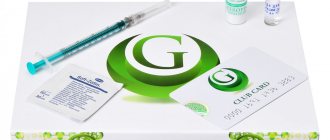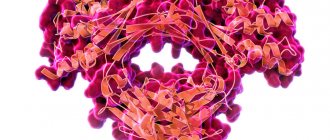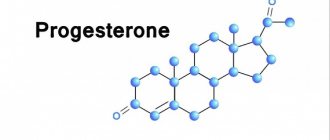Serotonin, which is often called the “happiness hormone” or “good mood hormone,” is involved in various physiological processes in the body. It directly affects the regulation of sleep, mood, digestion, and the functioning of the reproductive system.
Where does it come from? How do you know if you have a serotonin deficiency? And what legal remedies and solutions exist that help increase the level of the happiness hormone? Read the answers to these questions in the article.
What is serotonin
Today, scientists know that hormones affect our perception of the world more than we might imagine. While the average person is upset and looks for the reasons for his depression in external circumstances, his mood, reactions, desires and even the direction of his thoughts are controlled by the hormonal system. Serotonin is directly related to libido, appetite, physical and mental activity. With balance, there is a satisfactory state of health and a sufficient amount of energy, pain sensitivity decreases and appearance improves. A person suffering from a lack of serotonin will be lethargic, pessimistic and irritable.
The synthesis of 80-90% of serotonin occurs in the intestines, and only 10-20% is produced in the brain. Therefore, proper nutrition is the most effective way to replenish the happiness hormone.
Problems with foods rich in tryptophan
When we eat, tryptophan from protein-rich foods enters the body and is transferred to the intestinal tract. Most of the tryptophan is then converted to serotonin and stored there. Only a small proportion of tryptophan reaches the brain. But this small amount is quite enough.
The problem is that tryptophan requires transport to reach the brain. Amino acids (the building blocks of protein) also require substances that can transport them. If the body has too many amino acids that need to be transported, less tryptophan will reach the brain.
How does serotonin interact in the body?
Serotonin is a chemical substance that transmits certain information to nerve cells through electrical impulses. It contains commands that encourage the body to move and the brain to rejoice. This is the simple physiological secret of cheerfulness and efficiency.
A lack of the happiness hormone has a detrimental effect on the body, but this does not mean that the principle “the more the better” is appropriate here. Excess is also detrimental to health.
How to control the amount of happiness hormone
Research confirms that positive emotions and agreeableness contribute to positive relationships with others. This, in turn, creates conditions for minimizing stress - one of the factors of low serotonin levels.
Play sports and move more, walk. Physically active people have fewer problems with the production of the happiness hormone.
Try to always think positively and do not spoil your mood with unimportant problems. A bad mood leads to a deficiency of serotonin, and a deficiency leads to a bad mood. You drive yourself into a vicious circle if you perceive external stimuli too painfully.
Signs of Serotonin Deficiency
The following signs may indicate insufficient production of this necessary inhibitor:
- Fast fatiguability;
- Emotional imbalance, vulnerability;
- Regularly recurring headaches;
- Depression;
- Decreased or, conversely, excess appetite;
- Insomnia;
- Inhibited, disordered thinking;
- Memory impairment;
- Craving for alcohol.
An experiment performed on monkeys demonstrated that serotonin affects not only character and behavior, but also social status. Scientists chose from the pack the most cowardly, but at the same time, prone to impulsive manifestations of aggression, male. Naturally, such a primate could not enjoy the respect of his fellow tribesmen. But after receiving a dose of the hormone, his posture straightened, and his reactions became much more confident and calm. Thus, the former omega turned into a worthy competitor for the leader of the pack.
A similarly low level of serotonin production is observed in the group most susceptible to neuroses and depressive states. Physiological support and work with a psychologist help these patients become more morally stable and increase their importance in society.
Foods rich in tryptophan
Eggs
Eggs are one of the breakfast staples as they are very nutritious. In fact, egg yolks are very rich in tryptophan. 100 g of product contains 210 mg of tryptophan. In addition, eggs are rich in proteins. However, increasing serotonin levels can be problematic.
Turkey and chicken
A 100-gram serving of turkey or chicken breast contains 350 to 390 mg of tryptophan. This substance is present in any meat, but turkey and chicken breast are considered the healthiest products because they are quite low in fat and cholesterol.
Cheese
Cheese is very rich in tryptophan - about 575 mg of tryptophan per 100 g of cheese. In addition, cheese contains calcium (good for bones), vitamin B12 (for the nervous system) and proteins.
Beans
Kidney beans, black beans, and split peas contain 180 mg of tryptophan per cup. In addition, they are rich in fiber (which remarkably cleanses the blood, which in turn is useful for diseases such as heart failure), as well as proteins.
Seafood
Fatty fish contains about 250-400 mg of tryptophan per serving, while 100 g of shrimp will add 330 mg of tryptophan. Seafood also has other health benefits thanks to its high omega-3 fatty acids and vitamins.
Oatmeal
Another product that will help increase serotonin in the body using folk remedies is oatmeal. For every 100g of oatmeal you get 182mg of tryptophan. In addition, oatmeal contains many beneficial substances, such as vitamin B6 (helps improve mood, metabolism and healthy sleep), as well as fiber.
Soy
100 g of soybeans contain 590 mg of tryptophan. Soy can be found in foods such as tofu and other meat substitutes. However, research shows that the effects of soy on human health are quite controversial. Some scientific studies show that this product reduces the risk of heart disease, while others indicate the likelihood of developing breast cancer. Therefore, you should be careful and try not to consume soy in large quantities.
Nuts
Nuts are one of the healthiest foods. Almonds, walnuts and cashews contain 50 mg of tryptophan per quarter cup.
Pumpkin seeds
Pumpkin isn't just for Halloween, and there's a good reason for that - it's rich in tryptophan. A quarter cup of pumpkin seeds provides 110 mg of this substance. Other grains, such as sunflower seeds, are also rich in tryptophan.
Beetroot
Beets contain tryptophan and folic acid, which also help with depression.
Sea vegetables
Brown and seaweeds contain tryptophan. If you have questions about how to consume them, try combining them with smoothies, salads and soup.
Foods that increase serotonin levels
When you are in a bad mood, you always want to eat something tasty, and this is not without reason. Buns, cakes, pastries and sweets, which the fair sex especially loves, contain fast carbohydrates. Thanks to them, the body receives a sufficient dose of glucose in a short time, and the mood rises sharply. But the effect subsides just as quickly, as a result of which the consumer, without hesitation, puts a new portion of sweets in his mouth to relieve tension, and becomes a prisoner of the vicious circle of addiction.
To improve your quality of life and get rid of overeating, you need to learn to replace simple carbohydrates with complex ones. When consuming them, sugar will enter the blood in small portions over a long period of time, and serotonin will be steadily produced for several hours. Complex carbohydrates include:
- Potato;
- Peas;
- Beans;
- Lentils;
- Wholemeal bread;
- Oatmeal;
- Muesli;
- Vegetables and fruits.
To significantly increase serotonin production, you need to eat foods containing the amino acid tryptophan. These include:
- hard cheeses,
- soy and soy products,
- processed cheese,
- fatty cottage cheese,
- oyster mushrooms,
- chicken eggs,
- lean meat.
Additionally, doctors advise allowing yourself a cup of aromatic natural coffee every day, as well as including foods high in vitamin B and dark chocolate in your diet.
The role of serotonin receptors in the motor-evacuation function of the gastrointestinal tract
The main classes of receptors involved in the regulation of motor-evacuation function of the gastrointestinal tract (GIT) are cholinergic, adrenergic, dopaminergic, serotonin, motilin and cholecystokinin. Drugs used for depressive and anxiety disorders, panic attacks and other autonomic dysfunctions act on the same receptors that are responsible for the motor-evacuation function of the gastrointestinal tube. Regulation of smooth muscle activity and intestinal motility occurs at several levels. Hormones and neurotransmitters are the dominant components that directly or indirectly affect smooth muscle cells. The postprandial endocrine response includes the production of insulin, neurotensin, cholecystokinin (CCK), gastrin, glucagon-like peptides (GLP-1 and GLP-2), glucose-dependent insulinotropic polypeptide (GIP, formerly known as gastric inhibitory peptide) [1], effect data neurotransmitters and hormones are presented in table. 1. For example, CCA is secreted in the proximal small intestine and directly influences the contraction of gallbladder muscle cells and the neuromediated relaxation of sphincter of Oddi cells, which is mediated through the GIP neuromuscular junction.
In this article, special attention is paid to serotonergic receptors, which are one of the important regulators of intestinal motility. Serotonin, or 5-hydroxytryptamine (5-HT), is a monoamine neurotransmitter that is the main mediator in the physiology of a person’s psychological state and mood, as well as one of the regulators of vascular function and gastrointestinal motility. 5-HT is known to be present in platelets, the gastrointestinal tract, and the central nervous system of humans and animals [2–5]. Serotonin is produced in the human body from the amino acid tryptophan supplied with food - since it is precisely this that is needed for the direct synthesis of serotonin in synapses; the second pathway for the production of serotonin is associated with the supply of glucose with carbohydrate foods, which stimulates the release of insulin into the blood, followed by protein catabolism in tissues, which also leads to an increase in the level of tryptophan in the blood.
Based on biochemical and pharmacological criteria, 5-HT receptors are divided into seven main subtypes, five of which are found in enterochromaffin neurons, enterochromaffin (EC) cells and gastrointestinal smooth muscle: 5-HT1, 5-HT2, 5-HT3, 5 -HT4 and 5-HT7 [6, 7]. About 80% of the total number of 5-HT receptors are located in intestinal Echo cells, where they participate in intestinal motility through several subtypes of 5-HT receptors [8, 9]. With the exception of 5-HT3 receptors, a gated ion channel ligand, all 5-HT receptors bind to G protein receptors, which activate second-cascade intracellular reactions, stimulating excitatory or inhibitory responses in the gastrointestinal tract [10]. Serotonin has well-studied effects on intestinal motility, secretion and sensitivity through central and peripheral neurotransmitter pathways, making it a key pharmacological agent used in the treatment of gastrointestinal motility disorders [11]. Serotonin is released from EC cells in response to chemical or mechanical stimulation of the mucosa [12] or in response to experimental models of stress [13]. Serotonin is synthesized and stored not only in EC cells (90%), but also in intestinal neurons (10%). As mentioned above, 5-HT is released into the blood after eating and in response to changes in pressure in the intestinal wall, as well as when exposed to harmful stimuli [13], and then enters the intestinal lumen and further into its walls from the basolateral depot of ECH cells [14]. 5-HT stimulates the circular and longitudinal muscles of the stomach, duodenum and jejunum [15]. The strategic location of EC cells in close proximity to sensory nerve endings of the intestinal mucosa, interganglionic neurons, and synapses of motor excitatory and inhibitory neurons is important. Serotonin increases the contraction amplitude of the muscles of the stomach, duodenum, jejunum and ileum [16]. In the small intestine, 5-HT stimulates circular muscle contractions during the first manometric phase, the resulting contractions spread, become more frequent and activate fast motor complexes [17]. In the colon, serotonin stimulates motility along the entire length, causing phasic contractions, but not giant motor complexes [18]. Intestinal smooth muscle rhythmic oscillations are determined by the spontaneous activity of interstitial cells of Cajal, which act as a pacemaker for cells in the gastrointestinal tract [19–22]. The enteric nervous system (ENS) consists of semi-autonomous effector systems that are connected to the central autonomic system. When serotonin is released from enterochromaffin cells, vagal reflexes are initiated - peristaltic, excretory, vasodilatory, nociceptive. The parasympathetic and sympathetic divisions of the autonomic nervous system form the CNS through afferent and efferent connections. The ongoing bidirectional relationship of the brain-gut reflex arc involving 5-HT has a significant impact on effector systems. Impaired 5-HT transmission can lead to both intestinal and extraintestinal manifestations of irritable bowel syndrome (IBS) [23].
The degree of participation of various 5-HT in the functional peristaltic activity of the gastrointestinal tract is divided as follows - 5-HT3 - 65%, 5-HT4 - 85% and 5-HT7 - 40%. When combined, antagonists of these receptors, given in pairs, are able to reduce intestinal peristaltic activity by approximately 16% (5-HT3 + 5-HT4), 70% (5-HT3 + 5-HT7) and 87% (5-HT4 + 5-HT7), and the simultaneous administration of all three antagonists inevitably blocks all peristaltic activity. Thus, 5-HT receptors play a key role in modulating intestinal motility by simultaneously blocking three receptors and inhibiting peristaltic activity. Among the 5-HT receptors of the gastrointestinal tract, the 5-HT4 subtype is the most functionally important for peristalsis, and the 5-HT3 and 5-HT7 receptors play a slightly less active role in this process, as reflected in Table. 2 and in Fig. 1 [24].
5-HT4 agonists became available with the introduction of metoclopramide in 1964. This drug is a dopamine D2 and 5-HT3 receptor antagonist and a 5-HT4 receptor agonist and is still widely used throughout the world. Its success has led to the development of alternative molecules that do not affect D2 receptors, thereby eliminating adverse events such as akathisia and extrapyramidal movement disorders.
Serotonin receptors, in particular 5-HT3 and 5-HT4, are involved in sensory and reflex responses to stimuli in gastrointestinal disorders, causing manifestations such as vomiting, constipation or diarrhea, eating disorders, abdominal pain, altered sensorimotor reflexes [25 ]. It has been suggested that selective serotonin reuptake inhibitors (SSRIs) may affect 5-HT3 receptor function and may also improve symptoms of IBS and comorbid depression in patients. According to a number of studies and reviews [26–29], tricyclic antidepressants (amitriptyline, Melipramine), antidepressants of a number of SSRIs, such as fluoxetine, paroxetine, citalopram, clomipramine, litoxetine, trazodone, and a number of selective serotonin and norepinephrine reuptake inhibitors (SSRIs) ( duloxetine) improves IBS symptoms. Long-term side effects of this therapy are common to antidepressant treatment and include anticholinergic, serotonergic, sedative, antihistamine, and alpha-adrenergic effects. These effects must be taken into account when choosing a treatment approach, since the drugs described above affect intestinal motility, the patient's bowel function should also be taken into account when choosing serotonergic drugs (Fig. 2) [30].
As stated previously, the 5-HT1, 5-HT3, and 5-HT4 receptor subtypes play important roles in the motor, sensory, and secretory functions of the gastrointestinal tract. Drugs that directly affect 5-HT receptors, unlike tricyclic antidepressants and SSRIs, modulate 5-hydroxytryptamine (5-HT) by binding to 5-HT receptors; their characteristics are shown in Table. 3. Intestinal functions of 5-HT receptors are associated with smooth muscle, increased bowel movements, and decreased intestinal transit time [31, 32]. Blockade of 5-HT3 receptors, in particular by antiemetics such as ondansetron, leads to constipation [33]. Over the past decade, the 5-HT3 receptor blockers alosetron and silansetron have been developed and tested for IBS-D (IBS with diarrhea). A recent systematic review and meta-analysis of 11 randomized controlled trials (RCTs) comparing these two 5-HT3 antagonists with placebo found a beneficial effect [34]. However, a number of rare side effects, including ischemic colitis and severe constipation, led to the suspension of alosetron production and research on silansetron [35]. Alosetron is currently available only under strict indications (in the US) for patients with severe refractory IBS with diarrhea who have not responded to first or second line therapy.
5-HT4 agonists have proven their therapeutic potential for the treatment of patients with gastrointestinal motility disorders. Drugs that lack selectivity for 5-HT4 receptors have limited clinical success in gastroenterological practice. For example, in addition to their affinity for 5-HT4 receptors, drugs such as cisapride and tegaserod also have marked affinity for other receptors, channels, or transmitter proteins. The adverse cardiovascular events observed with these agents are due to their nonselectivity and crossover effects. A systematic review and meta-analysis found that tegaserod is superior to placebo in the treatment of constipation, including IBS. Most of the studies related to tegaserod were conducted in women, and as a result, the drug was initially approved for the treatment of IBS-C (IBS with constipation) only in women. However, marketing of tegaserod was also suspended when data on a possible increase in cardiovascular and cerebrovascular events with the drug were reported [6].
An important event in clinical pharmacology was the discovery of a selective ligand (ligand, from Latin ligare - to bind, an atom, ion or molecule associated with a certain center (acceptor), the term is used in biochemistry to designate agents that combine with biological acceptors - receptors, immunoglobulins and etc.) to the 5-HT4 receptor - prucalopride. The selectivity of this new drug significantly distinguishes it from older generations of alternative drugs by minimizing the potential for side effects. In addition, the concept of searching for similar ligands opens up broad opportunities for further drug development and the creation of agonist-specific effects in various types of cells, tissues or organs. The selective 5-HT4 receptor agonist prucalopride is an innovative drug with an attractive safety profile for the treatment of patients suffering from hypomotility gastrointestinal disorders [36]. Prucalopride has high affinity and selectivity for 5-HT4 receptors in the gastrointestinal tract. During the existence of the drug prucalopride, several large and long-term studies were conducted, which made it possible to fully evaluate the risks and benefits of using prucalopride for chronic constipation [36–38]. Overall, prucalopride was associated with consistent and significant improvements in patient satisfaction with their treatment, as assessed by the Patient Assessment of Constipation Quality of Life questionnaire (PAC-QOL). The proportion of participants receiving prucalopride 2 mg daily who reported an improvement of ≥ 1 point on the PAC-QOL 5-point subscale was 45.3%, compared with 21.3% of those receiving placebo (p ≤ 0.001), but the response rate in almost all studies was less than 50%. The other trials, PRU-USA-11 and PRU-USA-13, found no significant difference between prucalopride and placebo at all surrogate points. The overall incidence of adverse events was statistically significantly higher in patients receiving prucalopride (72%) compared with patients receiving placebo (59%) (hazard ratio (RR) 1.21, 95% confidence interval (CI): 1.06 , 1.38). The adverse events most commonly reported by patients receiving prucalopride were headache (up to 30%), nausea (up to 24%), diarrhea (up to 5%), abdominal pain and flatulence (up to 23%), dizziness (up to 5 %) and upper respiratory tract infections [39]. R. Cinca et al. compared the effectiveness, safety and impact on quality of life of macrogol and prucalopride in 240 women with chronic constipation for whom other laxatives did not provide adequate relief. In this study, macrogol was more effective than prucalopride for the treatment of chronic constipation and was better tolerated [40]. As a result, we can conclude that prucalopride can be prescribed by a doctor experienced in the treatment of chronic constipation to women from 18 to 75 years of age if other laxatives have not been effective in their treatment.
It is important to know that patients do not always have a deficiency of serotonin; in some cases, the doctor may encounter an excess of it. In restless gastroenterological patients who have elevated serotonin levels, aerophagia develops, which causes an increase in the air bubble in the stomach and leads to irritation of the receptor apparatus [41]. Elevated levels of serotonin cause frequent nausea and vomiting due to activation of the vagus nerve, diarrhea or spastic constipation, gastrointestinal panic attacks, headache, tremor, hyperhidrosis, agitation and anxiety, palpitations, unstable blood pressure, insomnia.
Serotonin plays an important role not only in the regulation of motility and secretion in the gastrointestinal tract, enhancing its peristalsis and secretory activity, but is also a growth factor for some types of symbiotic microorganisms and enhances bacterial metabolism in the colon. The colon bacteria themselves also make some contribution to the intestinal secretion of serotonin, since many species of commensal bacteria have the ability to decarboxylate tryptophan. With dysbiosis and a number of other diseases of the colon, the production of serotonin by the intestines is significantly reduced. The massive release of serotonin from dying cells of the gastric and intestinal mucosa under the influence of cytotoxic chemotherapy is one of the causes of nausea and vomiting, as well as diarrhea during chemotherapy for malignant tumors [42, 43].
It is difficult to overestimate the role of serotonin in the human body. In the front part of the brain, under the influence of serotonin, areas responsible for the process of cognitive activity are stimulated, and an increase in serotonergic activity creates a feeling of uplift in the cerebral cortex. Serotonin entering the spinal cord has a positive effect on motor activity and muscle tone; this state can be characterized by the phrase “I can move mountains.” In addition to mood, serotonin is “responsible” for self-control or emotional stability. Serotonin controls the sensitivity of brain receptors to stress hormones adrenaline and norepinephrine. In people with low serotonin levels, the slightest trigger triggers a massive stress response. Some researchers believe that the dominance of an individual in the social hierarchy is due precisely to the high level of serotonin [42, 43].
Conclusion
When food enters the body, including food containing tryptophan, the production of serotonin increases, which improves mood. The brain quickly grasps the connection between these phenomena and, in the case of depression (serotonin starvation), immediately “demands” additional food intake with tryptophan or glucose. The richest foods in tryptophan are those that consist almost entirely of carbohydrates, for example, bread, bananas, chocolate, figs, dried apricots, dates, raisins, watermelons, etc. The listed products have long been known as regulators of intestinal motility. Their nutritional deficiency leads to depression and gastrointestinal problems, which can often be observed in people following a strict low-calorie diet. For this reason, before prescribing medications to a patient that increase serotonin levels, it is necessary to clarify the cause of its deficiency. Knowledge of the details of the structure of serotonin receptors will undoubtedly find application in treating patients with non-cardiotoxic serotonin analogues or drugs that increase serotonin levels, which will perform their healing function and will be pleasant in all respects, for example, such as chocolate [44]. Drugs that increase the level of serotonin in the synaptic cleft and enhance its effects belong to the group of antidepressants. Today they are among the most prescribed medications by general medical practitioners in many countries around the world, including Europe and North America. Timely prescription of antidepressants, both in monotherapy and in treatment regimens for various diseases, can increase the effectiveness of treatment of the underlying disease and improve the quality of life of patients, especially in gastroenterological patients.
Literature
- Medhus A.W., Sandstad O., Naslund E. at al. The influence of the migrating motor complex on the postprandial endocrine response // Scand J Gastroenterol. 1999. 34. R. 1012–1018.
- Buchheit KH, Engel G., Mutschler E., Richardson B. Study of the contractile effect of 5-hydroxytryptamine (5-HT) in the isolated longitudinal muscle strip from guinea pig ileum. Evidence for two distinct release mechanisms // Naunyn Schmiedebergs Arch Pharmacol. 1985. 329. R. 36–41.
- Kim DY, Camilleri M. Serotonin: a mediator of the brain-gut connection // Am J Gastroenterol. 2000. 95. R. 2698–2709.
- Woollard DJ, Bornstein JC, Furness JB Characterization of 5-HT receptors mediating contraction and relaxation of the longitudinal muscle of the guinea pig distal colon in vitro // Naunyn Schmiedebergs Arch Pharmacol. 1994. 349. R. 455–462.
- Yamano M., Ito H., Miyata K. Species differences in the 5-hydroxytryptamine-induced contraction in the isolated distal ileum // Jpn J Pharmacol. 1997. 74. R. 267–274.
- De Maeyer JH, Lefebvre RA, Schuurkes JA 5-HT4 receptor agonists: similar but not the same // Neurogastroenterol Motil. 2008. 20. R. 99–112.
- Hannon J., Hoyer D. Molecular biology of 5-HT receptors // Behav Brain Res. 2008. 195. R. 198–213.
- Kim DY, Camilleri M. Serotonin: a mediator of the brain-gut connection // Am J Gastroenterol. 2000. 95. R. 2698–2709.
- Berger M., Gray JA, Roth BL The expanded biology of serotonin // Annu Rev Med. 2009. 60. R. 355–366.
- Hannon J., Hoyer D. Molecular biology of 5-HT receptors // Behav Brain Res. 2008. 195. R. 198–213.
- Crowell MD Role of serotonin in the pathophysiology of the irritable bowel syndrome // Br J Pharmacol. 2004. 141. R. 1285–1293.
- Gershon MD Plasticity in serotonin control mechanisms in the gut // Curr Opin Pharmacol. 2003. 3. R. 600–607.
- Bearcroft CP, Perrett D., Farthing MJ Postprandial plasma 5-hydroxytryptamine in diarrhoea predominant irritable bowel syndrome: a pilot study // Gut. 1998. 42. R. 42–46.
- Hansen MB Small intestinal manometry // Physiol Res. 2002. 51. R. 541–556.
- Fishlock DJ, Parks AG, Dewell JV Action of 5-hydroxytryptamine on the human stomach, duodenum, and jejunum in vitro // Gut. 1965. 6. R. 338–342.
- Hopkinson GB, Hinsdale J., Jaffe BM Contraction of canine stomach and small bowel by intravenous administration of serotonin. A physiological response? // Scand J Gastroenterol. 1989. 24. R. 923–932.
- Hansen MB, Gregersen H., Husebye E., Wallin L. Effect of serotonin and ondansetron on upper GI manometry in healthy volunteers // Neurogastroenterol Motil. 2000. 12. R. 281.
- Boerckxstaens GE, Pelckmans PA, Rampart M. at al. Pharmacological characterization of 5-hydroxytryptamine receptors in the canine terminal ileum and ileocolonic junction // J Pharmacol ExpTher. 1990. 254. R. 652–658.
- Alberti E., Mikkelsen HB, Larsen JO, Jimenez M. Motility patterns and distribution of interstitial cells of Cajal and nitrergic neurons in the proximal, mid- and distal-colon of the rat // Neurogastroenterol Motil. 2005. 17. R. 133–147.
- Sanders KM A case for interstitial cells of Cajal as pacemakers and mediators of neurotransmission in the gastrointestinal tract // Gastroenterology. 1996. 111. R. 492–515.
- Thomsen L., Robinson T.L., Lee J.C. at al. Interstitial cells of Cajal generate a rhythmic pacemaker current // Nat Med. 1998. 4. R. 848–851.
- Park SY, Je HD, Shim JH, Sohn UD Characteristics of spontaneous contraction in the circular smooth muscles of cat ileum // Arch Pharm Res. 2010. 33. R. 159–165.
- Crowell MD Role of serotonin in the pathophysiology of the irritable bowel syndrome // Br J Pharmacol. 2004. 141 (8). R. 1285–1293.
- Balestra B., Vicini R., Pastoris O. at al. 5-HT receptors and control of intestinal motility: expression and hierarchical role // Poster Session, Bologna. 2011.
- Read NW, Gwee KA The importance of 5-hydroxytryptamine receptors in the gut // Pharmacol Ther. 1994. Apr-May; 62 (1–2). R. 159–173.
- Lucchelli A., Santagostino-Barbone MG, Barbieri A. at al. The interaction of antidepressant drugs with central and peripheral (enteric) 5-HT3 and 5-HT4 receptors // Br J Pharmacol. 1995. Mar; 114(5). R. 1017–1025.
- Ford AC, Talley NJ, Schoenfeld PS, Quigley EM, Moayyedi P. Efficacy of antidepressants and psychological therapies in irritable bowel syndrome: systematic review and meta-analysis // Gut. 2009. Mar; 58(3). R. 367–378.
- Friedrich M., Grady SE, Wall GC Effects of antidepressants in patients with irritable bowel syndrome and comorbid depression // Clin Ther. 2010. July; 32(7). R. 1221–1233.
- Chial HJ, Camilleri M, Burton D at al. Selective effects of serotonergic psychoactive agents on gastrointestinal functions in health // Am J Physiol Gastrointest Liver Physiol. 2003. 284. G130-G137.
- Turvill JL, Connor P., Farthing MJ The inhibition of cholera toxin-induced 5-HT release by the 5-HT (3) receptor antagonist, granisetron, in the rat // Br J Pharmacol. 2000. 130. R. 1031–1036.
- Ruckebusch Y., Bardon T. Involvement of serotonergic mechanisms in initiation of small intestine cyclic motor events // Dig Dis Sci. 1984. 29. R. 520–527.
- Haus U., Spath M., Farber L. Spectrum of use and tolerability of 5-HT3 receptor antagonists // Scand J Rheumatol Suppl. 2004. 119. R. 12–18.
- Ford AC, Brandt. LJ, Young C. at al. Efficacy of 5-HT3 antagonists and 5-HT4 agonists in irritable bowel syndrome: Systematic review and metaanalysis // Am J Gastroenterol. 2009. 104. R. 1831–1843.
- US Food and Drug Administration. Glaxo Wellcome withdraws irritable bowel syndrome medication // FDA Consum. 2001. 35. R. 3.
- Johanson JF, Drossman DA, Panas R., Wahle A., Ueno R. Clinical trial: phase 2 study of lubiprostone for irritable bowel syndrome with constipation // Aliment. Pharmacol. 2008. 27. R. 685–696.
- Camilleri M., Kerstens R., Rykx A., Vandeplassche L. A Placebo-Controlled Trial of Prucalopride for Severe Chronic Constipation // N Engl J Med. 2008. 358. R. 2344–2354.
- Tack J., van Outryve M., Beyens G., Kerstens R., Vandeplassche L. Prucalopride (Resolor) in the treatment of severe chronic constipation in patients dissatisfied with laxatives // Gut. 2009; 58: 357–565.
- Quigley E.M., Vandeplassche L., Kerstens R., Ausma J. Clinical trial: the efficacy, impact on quality of life, and safety and tolerability of prucalopride in severe chronic constipation a 12-week, randomized, double-blind, placebo-controlled study // Aliment Pharmacol Ther. 2009; 29: 315–328.
- https://www.pbs.gov.au/industry/listing/elements/pbac-meetings/psd/2012–7/prucalopride.pdf.
- Cinca R., Chera D., Gruss HJ, Halphen M. Randomised clinical trial: macrogol/PEG 3350+electrolytes versus prucalopride in the treatment of chronic constipation - a comparison in a controlled environment // Aliment Pharmacol Ther. May 2013; 37(9). R. 876–886.
- Burov N. E. Nausea and vomiting in clinical practice (etiology, pathogenesis, prevention and treatment) // Russian Medical Journal. 2002. No. 16. pp. 390–395.
- Barinov E.F., Sulaeva O.N. The role of serotonin in the physiology and pathology of the gastrointestinal tract // RZHGGK. 2012. T. 21. No. 2. P. 4–13.
- Ashmarin I. P., Eshchenko N. D., Karazeeva E. P. Neurochemistry in tables and diagrams. M.: “Exam”, 2007. 143 p.
- Palczewski K., Kiser PD As good as chocolate // Science. 2013. 340. R. 562–563.
E. Yu. Plotnikova1, Doctor of Medical Sciences, Professor O. A. Krasnov, Doctor of Medical Sciences, Professor
State Budgetary Educational Institution of Higher Professional Education Kemerovo State Medical Academy of the Ministry of Health of the Russian Federation, Kemerovo
1 Contact information
About the importance of a healthy lifestyle
The statement that physical activity and walks in the fresh air lead to happiness is not an allegory, as it turns out, but a scientifically proven fact. Bright sunlight and movement are known to significantly stimulate serotonin production, so daytime walks are a great remedy. In addition, fresh air contains oxygen. You can walk or do simple exercises in the park, and if you are very enthusiastic, even join a gym or sports section.
Biological functions of the hormone
Serotonin is one of the most important hormones in the human body, therefore it has a considerable number of biological functions:
- stabilizes the functioning of the endocrine system;
- has a beneficial effect on hormone production;
- activates motor activity;
- reduces the pain threshold;
- prevents immunological disorders;
- protects the body from stress;
- responsible for transmitting impulses to muscle tissue;
- promotes blood clotting;
- has a positive effect on milk production in women who breastfeed;
- prevents the appearance of disturbances in the reproductive system, normalizes the menstrual cycle.
Drugs
There are medications that can increase the amount of serotonin that enters the blood. They fall into the category of antidepressants and are called selective reuptake inhibitors. These include the following drugs: Fluoxetine, Paroxetine, Venlafaxine, Sertraline, etc. It is not recommended to purchase and take medications without a doctor’s prescription. Uncontrolled use risks overdose. In this case, painful hyperactivity, nervous spasms, sleep disorders, and headaches may occur.
How do vitamins for a good mood work?
Unlike antidepressants, which inhibit serotonin reuptake, plant-based vitamins act differently—more gently. They bring all neurotransmitters into balance and help the happiness hormone be produced in the right quantity without causing serious harm to the human body:
- fight fatigue and irritability;
- increase memory, attention and concentration;
- eliminate insomnia and other sleep disorders;
- protect against depression and nervous disorders;
- restore interest in life and normalize appetite.
Constant stress at work and at home does not allow you to always be at the peak of activity. But now this problem can be easily solved: just one capsule of herbal vitamins a day - and it will be much easier for you to cope with the challenges that this world has prepared for you. Forgetfulness, absent-mindedness and apathy will be replaced by cheerfulness and a positive mood.
What products contain
For the active formation of serotonin, the amino acid tryptophan is needed. Serotonin syndrome develops against the background of poor nutrition and a deficiency of tryptophan, without which the transformation of the optimal amount of the hormone of happiness is impossible.
Serotonin in foods is not a source of the neurotransmitter, but receiving food with an important component and the amino acid tryptophan has a positive effect on hormonal levels. Metabolism of serotonin is impossible if there is a deficiency of a specific component in the menu.
It is important to know: the body does not synthesize tryptophan; a deficiency of foods rich in this important amino acid disrupts the optimal transformation of serotonin. A poor diet, the use of food items that negatively affect the body, negatively affect the gastrointestinal tract, interfere with the production of neurotransmitters.
The following foods increase tryptophan and serotonin levels:
- avocado,
- bananas,
- fish,
- nuts,
- seafood,
- apricots,
- dates,
- meat,
- chocolate (bitter), cocoa,
- cottage cheese,
- hard cheese,
- soybean,
- oyster mushrooms,
- figs,
- tomatoes,
- plums,
- buckwheat,
- millet.
What foods contain estrogen for women and what is the rate of their consumption? We have the answer!
The characteristic symptoms of ovarian fibroma, methods of treatment and removal of the formation are written on this page.
Go to https://fr-dc.ru/hormones/follitropin/fsg-y-myzhchin.html and learn about the FSH norm in men, as well as about correcting hormone levels in case of deviations.
For active absorption of tryptophan, you need foods with vitamin B6 (pyridoxine) and magnesium:









